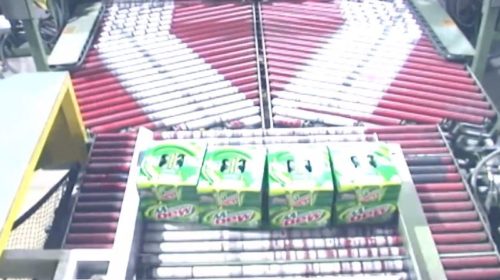
Rascher Amortisationsgewinn durch Trockeneisstrahlen
DIE SITUATION
Jokey ist einer der weltweit führenden Hersteller von Hartkunststoffverpackungen mit Deckel. Das Unternehmen stellt Kunststoffeimer und Kunststoffboxen im Kunststoffspritzgussverfahren her.
Seit 50 Jahren ist der Name Jokey als Garant für herausragende Kompetenz im Kunststoffspritzguss und kundenorientierten Service bekannt. Mit 2.000 Mitarbeitern produzieren sie ihre Produkte in 15 Werken in 12 Ländern und bedienen Kunden in rund 80 Ländern.
Im Produktionsprozess von Spritzgussteilen ist die Werkzeugreinigung ein entscheidender Schritt, insbesondere wenn es darum geht, die strengen Qualitäts-/Hygienevorschriften der Lebensmittelindustrie zu erfüllen.
“Die Reinigung ist für unser Endprodukt sehr wichtig, da sie sich direkt auf unsere Produktqualität auswirkt. Darüber hinaus sind einige unserer Produkte für den Lebensmittelmarkt bestimmt, so dass Sauberkeit unerlässlich ist,” sagt Herr Fontaine, Leiter der Formenwerkstatt.
Das Team von Jokey reinigt die Formen nach jedem Produktionsende und bei jeder Änderung oder Wartung der Werkzeuge. Das Unternehmen hat einen vorbeugenden Wartungsplan aufgestellt, bei dem die Reinigung eine der kritischen Phasen ist, die bei der Diagnose hilft. Alle Jokey-Werke verfügen über ein strenges Qualitäts- und Hygienemanagementsystem, das von unabhängigen Auditoren nach den internationalen Normen BRC/IoP für Verpackungen und Verpackungsmaterialien sowie nach DIN EN ISO 9001:2015 und DIN EN ISO 14.001:2015 geprüft und bewertet wird.
DIE AUFGABENSTELLUNG
Angesichts der zu respektierenden sehr hohen Hygienequalität benötigen die Produktionsmitarbeiter des Jokey-Werks einen hauptamtlichen Mitarbeiter (je nach Baureihe manchmal sogar mehr) für die Reinigung ihrer Spritzgießwerkzeuge. Vor der Verwendung des Cold Jet Trockeneisstrahlsystems erfolgte die Reinigung von Hand an einer Presse oder die Form wurde aus der Maschine entnommen und anschließend mit Tüchern und Reinigungsmitteln wie Aerosol-Lösungsmitteln oder einem Entfettungsbecken gereinigt.
„Manchmal war es notwendig, Equipment zur Reinigung zu demontieren und zu bewegen“, sagte Fontaine. „Das hat uns beunruhigt, weil es während der Stilllegung zweifellos einen Produktionsausfall gab. Während dieser Stillstände konnte die Form von 30 Minuten bis zu 2 Stunden nicht benutzt werden und konnte einen Formenbauer für die Reinigung beanspruchen. Im Extremfall konnte eine Demontage der Form erforderlich sein, was zu einem Produktionsausfall von bis zu 3 zusätzlichen Stunden führte. Diese Produktionsunterbrechungen konnten zwischen 1 und 5 Stunden dauern und somit erhebliche Produktionsverluste verursachen. Beim Anfahren der Produktion mussten wir außerdem 50 bis 200 Teile für die Entfernung von Spuren von Lebensmittellösungsmitteln am fertigen Produkt einbüßen.
“Die bisherige Reinigungslösung kann einen Einfluss auf die Qualität des Produkts haben. So mussten wir beispielsweise manchmal eine Presse nach der Reinigung anhalten, um Spuren von hartnäckigem Schmutz in schwer zugänglichen Bereichen zu beseitigen. Das Endprodukt, das nicht den Qualitätskriterien entsprach, musste vernichtet werden,” sagt Herr Fontaine. “In manchen Fällen mussten wir einige Aufträge wiederholen, weil sie nicht unseren Qualitätskriterien entsprachen.”
Ein weiteres Anliegen war die Sicherheit der Mitarbeiter, da der bisherige Reinigungsprozess gesundheitlich problematisch sein konnte, da Lösungsmittel in Aerosolen oder in einem Entfettungsbecken verwendet wurden. Diese Produkte erforderten eine Validierung durch arbeitsmedizinische und lebensmittelrechtliche Zertifikate. Die manuelle Reinigung an der Presse war wirklich nicht effektiv. Je nach Form dauerte es zwischen 45 Minuten und 2 Stunden. Die Herausforderungen an das alte System waren vielfältig, da es schwierig war alle Stellen mit dem gewünschten Qualitätsanspruch zu reinigen. Die Einwirkzeit war lang und der Einsatz von Tüchern und Reinigungsmitteln war unerlässlich.
DIE LÖSUNG
Vor der Wahl der Trockeneisstrahlreinigung versuchte das Unternehmen sowohl die Ultraschallreinigung als auch das Backpulverstrahlen ohne Erfolg. Das Unternehmen muss die Anforderungen der ISO 14001 erfüllen und verfügt über optimierte Produktionssysteme wie 5S und interne Produktionsverfolgungssysteme.
“Die Trockeneisstrahlreinigung unterstützt unsere Programme, weil sie uns Zeit spart und damit die Produktionszeit optimiert,” sagt Herr Fontaine. “Die Qualität der Reinigung ist auch besser.”
“Das Cold Jet Reinigungssystem ist kompakt, leicht beweglich und sehr effizient und dabei einfach zu bedienen. Die Reinigungszeit wird um etwa 50 % und manchmal sogar noch mehr reduziert. Die Zeitersparnis ist bei einem 4-Kavitäten-Werkzeug größer, da viel mehr gereinigt werden muss als bei einem kleineren Werkzeug (1 Kavität). Sie kann auch von der Anzahl der Teile abhängen, aus denen das Werkzeug besteht, denn je mehr Teile zu demontieren und damit zu reinigen sind, desto größer ist die Zeitersparnis. Das Trockeneisstrahlen hat unseren Formenbauern Zeit für komplexere Wartungs- oder Bearbeitungsvorgänge verschafft, die ein hohes Maß an Fachwissen erfordern.”
DIE ERGEBNISSE
Cold Jet Trockeneisstrahlen hat sich als vorteilhaft erwiesen:
- bei der Reduzierung der Reinigungszeit
- für eine genauere und effizientere Reinigung
- für die Beseitigung (oder sehr deutliche Verringerung) der Verwendung von Chemikalien
- für geringere Kosten durch die Beseitigung von verschmutzten Tüchern
- den Rückgang der Inbetriebnahmeverluste
- für die Umwelt
“Die Anfangsinvestition ist nach wie vor beträchtlich, aber die Amortisation erfolgt relativ schnell“, sagte Fontaine. „Die Amortisation von Cold Jet wurde vor dem Kauf der Maschine für den ausschließlichen Einsatz in unserem Formenbau berechnet. Dies vergleicht unsere alte Reinigungslösung mit der Cold Jet Reinigungslösung. Die Zeiten konnten dank der Leihgabe der Maschine für eine Woche unter realen Betriebsbedingungen gemessen werden. Damals stellten wir fest, dass die Rentabilität in weniger als 2 Jahren erreicht wurde (ohne die Kosten für die Produktionsunterbrechung und die Entsorgung der verschmutzen Tücher und Aerosolen).”
“Mit dem Cold Jet Reinigungssystem verbraucht das Personal weniger Chemikalien und die Reinigungszeit wird reduziert. Darüber hinaus ist das System lohnender und effizienter. Die erzielten Ergebnisse sind viel besser, und die Bediener müssen nicht die doppelte Arbeit leisten. Im Moment warten wir darauf, die MicroClean-Maschine noch rentabler zu machen und alle potenziellen Anwendungen in allen Abteilungen des Werks zu finden.”